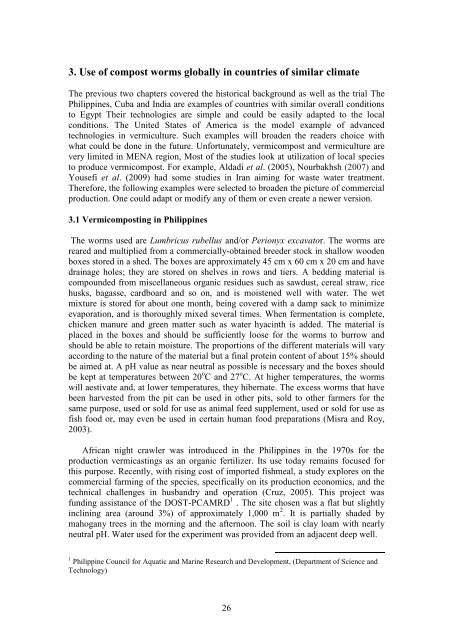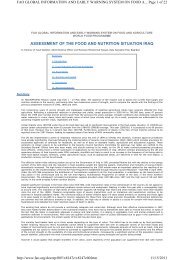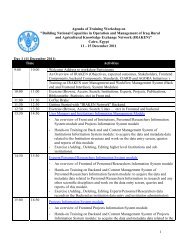Vermiculture in Egypt: - FAO - Regional Office for the Near East and
Vermiculture in Egypt: - FAO - Regional Office for the Near East and
Vermiculture in Egypt: - FAO - Regional Office for the Near East and
Create successful ePaper yourself
Turn your PDF publications into a flip-book with our unique Google optimized e-Paper software.
3. Use of compost worms globally <strong>in</strong> countries of similar climate<br />
The previous two chapters covered <strong>the</strong> historical background as well as <strong>the</strong> trial The<br />
Philipp<strong>in</strong>es, Cuba <strong>and</strong> India are examples of countries with similar overall conditions<br />
to <strong>Egypt</strong> Their technologies are simple <strong>and</strong> could be easily adapted to <strong>the</strong> local<br />
conditions. The United States of America is <strong>the</strong> model example of advanced<br />
technologies <strong>in</strong> vermiculture. Such examples will broaden <strong>the</strong> readers choice with<br />
what could be done <strong>in</strong> <strong>the</strong> future. Un<strong>for</strong>tunately, vermicompost <strong>and</strong> vermiculture are<br />
very limited <strong>in</strong> MENA region, Most of <strong>the</strong> studies look at utilization of local species<br />
to produce vermicompost. For example, Aldadi et al. (2005), Nourbakhsh (2007) <strong>and</strong><br />
Yousefi et al. (2009) had some studies <strong>in</strong> Iran aim<strong>in</strong>g <strong>for</strong> waste water treatment.<br />
There<strong>for</strong>e, <strong>the</strong> follow<strong>in</strong>g examples were selected to broaden <strong>the</strong> picture of commercial<br />
production. One could adapt or modify any of <strong>the</strong>m or even create a newer version.<br />
3.1 Vermicompost<strong>in</strong>g <strong>in</strong> Philipp<strong>in</strong>es<br />
The worms used are Lumbricus rubellus <strong>and</strong>/or Perionyx excavator. The worms are<br />
reared <strong>and</strong> multiplied from a commercially-obta<strong>in</strong>ed breeder stock <strong>in</strong> shallow wooden<br />
boxes stored <strong>in</strong> a shed. The boxes are approximately 45 cm x 60 cm x 20 cm <strong>and</strong> have<br />
dra<strong>in</strong>age holes; <strong>the</strong>y are stored on shelves <strong>in</strong> rows <strong>and</strong> tiers. A bedd<strong>in</strong>g material is<br />
compounded from miscellaneous organic residues such as sawdust, cereal straw, rice<br />
husks, bagasse, cardboard <strong>and</strong> so on, <strong>and</strong> is moistened well with water. The wet<br />
mixture is stored <strong>for</strong> about one month, be<strong>in</strong>g covered with a damp sack to m<strong>in</strong>imize<br />
evaporation, <strong>and</strong> is thoroughly mixed several times. When fermentation is complete,<br />
chicken manure <strong>and</strong> green matter such as water hyac<strong>in</strong>th is added. The material is<br />
placed <strong>in</strong> <strong>the</strong> boxes <strong>and</strong> should be sufficiently loose <strong>for</strong> <strong>the</strong> worms to burrow <strong>and</strong><br />
should be able to reta<strong>in</strong> moisture. The proportions of <strong>the</strong> different materials will vary<br />
accord<strong>in</strong>g to <strong>the</strong> nature of <strong>the</strong> material but a f<strong>in</strong>al prote<strong>in</strong> content of about 15% should<br />
be aimed at. A pH value as near neutral as possible is necessary <strong>and</strong> <strong>the</strong> boxes should<br />
be kept at temperatures between 20 o C <strong>and</strong> 27 o C. At higher temperatures, <strong>the</strong> worms<br />
will aestivate <strong>and</strong>, at lower temperatures, <strong>the</strong>y hibernate. The excess worms that have<br />
been harvested from <strong>the</strong> pit can be used <strong>in</strong> o<strong>the</strong>r pits, sold to o<strong>the</strong>r farmers <strong>for</strong> <strong>the</strong><br />
same purpose, used or sold <strong>for</strong> use as animal feed supplement, used or sold <strong>for</strong> use as<br />
fish food or, may even be used <strong>in</strong> certa<strong>in</strong> human food preparations (Misra <strong>and</strong> Roy,<br />
2003).<br />
African night crawler was <strong>in</strong>troduced <strong>in</strong> <strong>the</strong> Philipp<strong>in</strong>es <strong>in</strong> <strong>the</strong> 1970s <strong>for</strong> <strong>the</strong><br />
production vermicast<strong>in</strong>gs as an organic fertilizer. Its use today rema<strong>in</strong>s focused <strong>for</strong><br />
this purpose. Recently, with ris<strong>in</strong>g cost of imported fishmeal, a study explores on <strong>the</strong><br />
commercial farm<strong>in</strong>g of <strong>the</strong> species, specifically on its production economics, <strong>and</strong> <strong>the</strong><br />
technical challenges <strong>in</strong> husb<strong>and</strong>ry <strong>and</strong> operation (Cruz, 2005). This project was<br />
fund<strong>in</strong>g assistance of <strong>the</strong> DOST-PCAMRD 1 . The site chosen was a flat but slightly<br />
<strong>in</strong>cl<strong>in</strong><strong>in</strong>g area (around 3%) of approximately 1,000 m 2 . It is partially shaded by<br />
mahogany trees <strong>in</strong> <strong>the</strong> morn<strong>in</strong>g <strong>and</strong> <strong>the</strong> afternoon. The soil is clay loam with nearly<br />
neutral pH. Water used <strong>for</strong> <strong>the</strong> experiment was provided from an adjacent deep well.<br />
1 Philipp<strong>in</strong>e Council <strong>for</strong> Aquatic <strong>and</strong> Mar<strong>in</strong>e Research <strong>and</strong> Development, (Department of Science <strong>and</strong><br />
Technology)<br />
26





